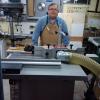Hi Everyone
I have a 6" Oshlun stacked dado set that I recently purchased with the intension that I wil use it to cut tenons (tenons to be mortised as well as bridle joints) and lap joints.
I'm not have much success getting flat cheeks. I have score marks from uneven blades in the stack I assume. Do these score marks really impact the joint itself? Should I clean them up with sandpaper wrapped around a block of wood? I don't have a shoulder plane....but this maybe a good reason to buy one
Alternatively I was also considering a horizontal router table which I know would give me a perfectly smooth tenon cheek but i would be limited by the length of the bit
TIA
George





 Reply With Quote
Reply With Quote

